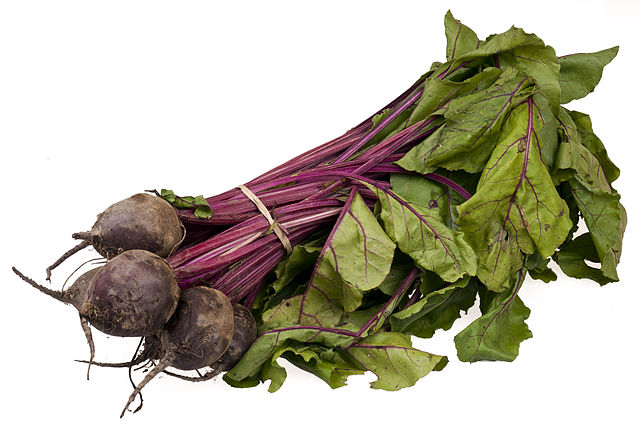Description
Beetroot is a dark green leafed plant up to 20 cm tall and grows throughout the year. It is also temperate climate plant and hence mainly grows in the highlands between 1150 and 2600 m altitude in the tropics. It has an oval shape with dark green or reddish in colour. It gives a thickened root in the first year followed by flowers in the second year. The flowers are small and green. The leaves vary in shape and colour. It has a round or elongated fattened root. The root is red in colour though there are also white varieties. There are many different varieties of beets, showcasing deep red, yellow, white, or striped roots of different shapes.
Red tubers are eaten after cooking. In some instances, the root is also dried and powdered after which the flour is mixed with barley or wheat. They can be pickled or fermented as beetroot juice. They are often boiled, sliced, and served with vinegar. The leaves are edible and can be cooked in soups and stews.
Planting requirements
Planting season: Mid April to late June
Planting conditions:
| Propagation | Plants are grown from seed. They produce seeds in their second year of growth. Soak the seeds overnight for 24 hours before planting the next day. Can also replant the young plant |
|---|---|
| Planting method | Sow seeds ½-inch deep and 1 to 2 inches apart in rows that are about 12 to 18 inches apart. After sowing, cover the seeds with a thin layer of soil |
| Soil | Need deep dug, rock-free soil, fertilized, well-drained soil. The beds should be fertilized normally, though adding a teaspoon of borax per thirty-two-square-foot bed is a good idea because beets are sensitive to boron deficiency. Adding compost will aid the process |
| Water | Need to water regularly to maintain moisture in the soil |
| Light | Partial shade, Full sun |
Growing conditions:
| Temperatures | As it requires a temperate climate, the plant grows best at 18-22°C and are frost resistant. Temperatures below 10°C cause the plant to start its seeding phase |
|---|---|
| Soil | Soil needs to have regular moisture to speed up germination. Beets need to maintain plenty of moisture to grow well |
| Water | Water the beetroot regularly to reduce the likelihood of the roots becoming woody or splitting. During the first month water every couple of days until the seeds have germinated |
| Pruning | Pinch off flower stalks if you want to prevent bolting and encourage more leaf growth. |
| Weed control | Keep the area clean by removing weeds regularly to reduce competition for nutrients and moisture |
Harvesting
It can be harvested once it has grown a couple of inches from the ground. Grasp the foliage firmly where it meets the top of the root and pull. Beetroot is better harvested too early rather than too late – younger roots are more tender. Beets should be harvested when they are no larger than 2” in diameter.
Curing
Beetroot does not require a curing stage.
Storage
Store beetroots in the refrigerator for up to three months or in the freezer for up to one year. To freeze, first blanch the beetroots for five minutes, then cool them quickly before placing them in a sealed bag in the freezer.
Protecting your plants
Pest control
Pest type:
- Leaf Miner (Liriomyza huidobrensis)
- Black Cutworm (Agrotis spp)
Symptoms:
Leaf Miner:
- Adults create punctures in leaves for feeding and oviposition, causing a spotted appearance on the foliage.
- Larvae create irregular mines in the leaves, leading to leaf drying and withering.
- Damaged plants are more vulnerable to secondary infections.
Black Cutworm:
- These pests are typically nocturnal.
- Early instar larvae create round holes in leaves.
- Later, they damage shoots near the ground, often cutting the entire plant at the base and pulling the stem belowground.
- Several plants may be cut in a single night, causing wilting during the day.
- They also create unsightly holes in tubers.
Control method:
Leaf Miner:
- Conduct regular field inspections.
- Use yellow sticky traps.
- Cover crops with suitable materials to prevent flies.
- Remove other host plants around the crop field.
- Remove and destroy infected plant material.
Black Cutworm:
- Regular monitoring
- Hand-collecting and destroying pests
- Weed management
- Maintain proper field sanitation
- Deep plowing to expose larvae and pupae
- Encourage predatory birds to prey on worms during tillage operations
Disease Control
Disease type:
- Cercospora Leaf Spot (Cercospora beticola)
- Root Rot
Symptoms:
Cercospora Leaf Spot: appears as dark spots with yellow haloes
Root Rot: causes blackened roots and wilting plants.
Management:
Cercospora Leaf Spot:
- Use of disease-free seeds
- Use sprinklers for watering
- Crop rotation
- Field sanitation
- Weed control
- Planting in proper spacing
Root Rot:
- Avoid overhead watering to prevent fungal diseases.
- Practice crop rotation and maintain good air circulation around plants.
- Apply fungicides if necessary.
Sources
In addition to our General List of Sources (link), we used these specific references:
